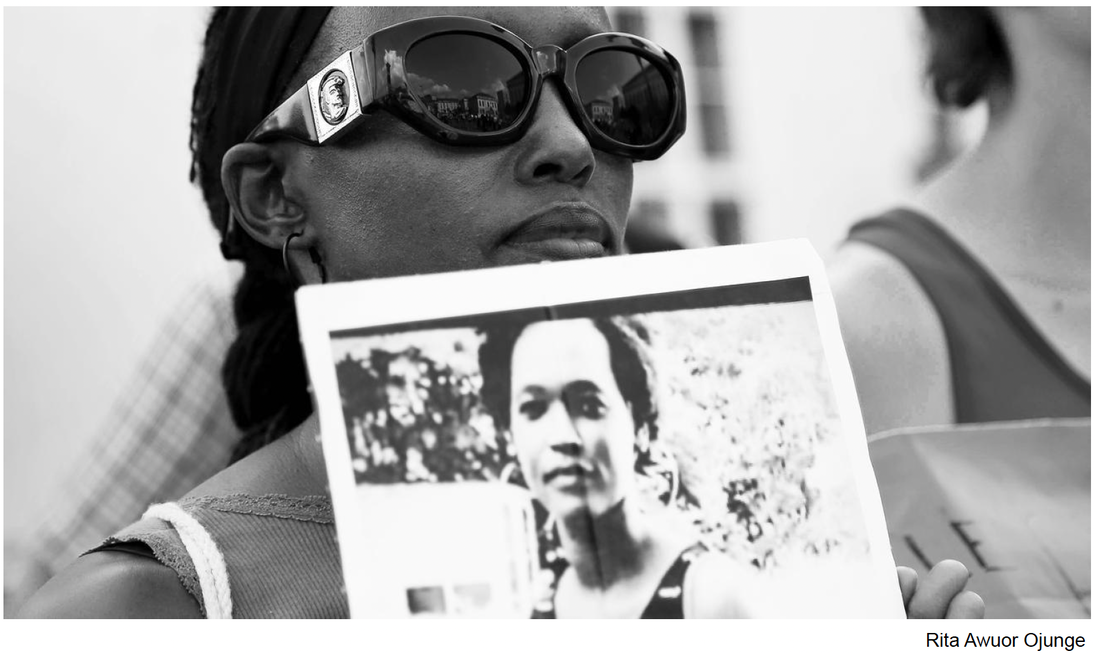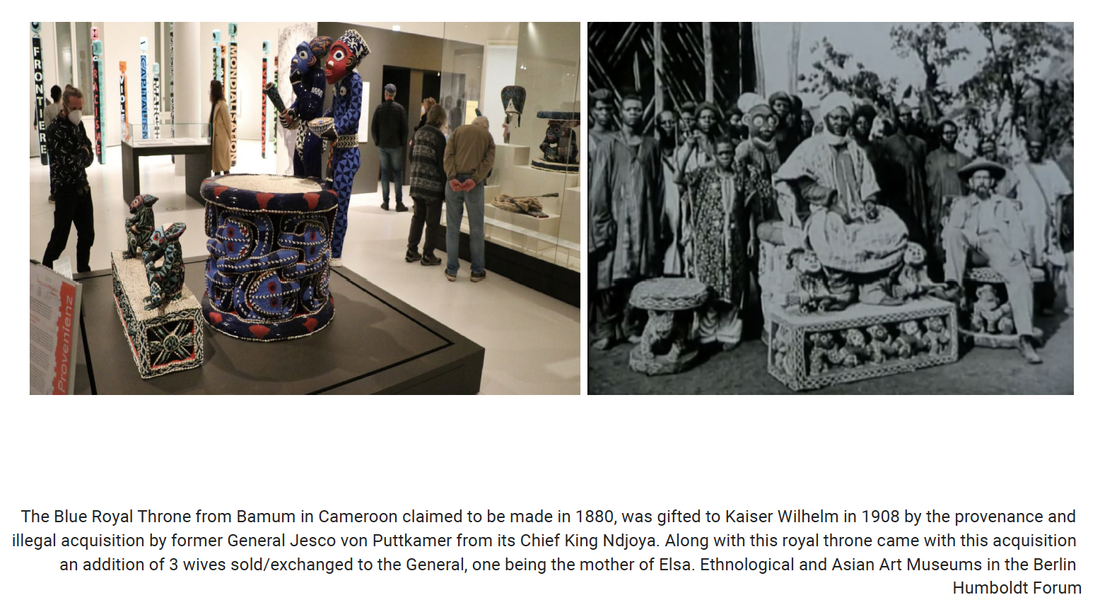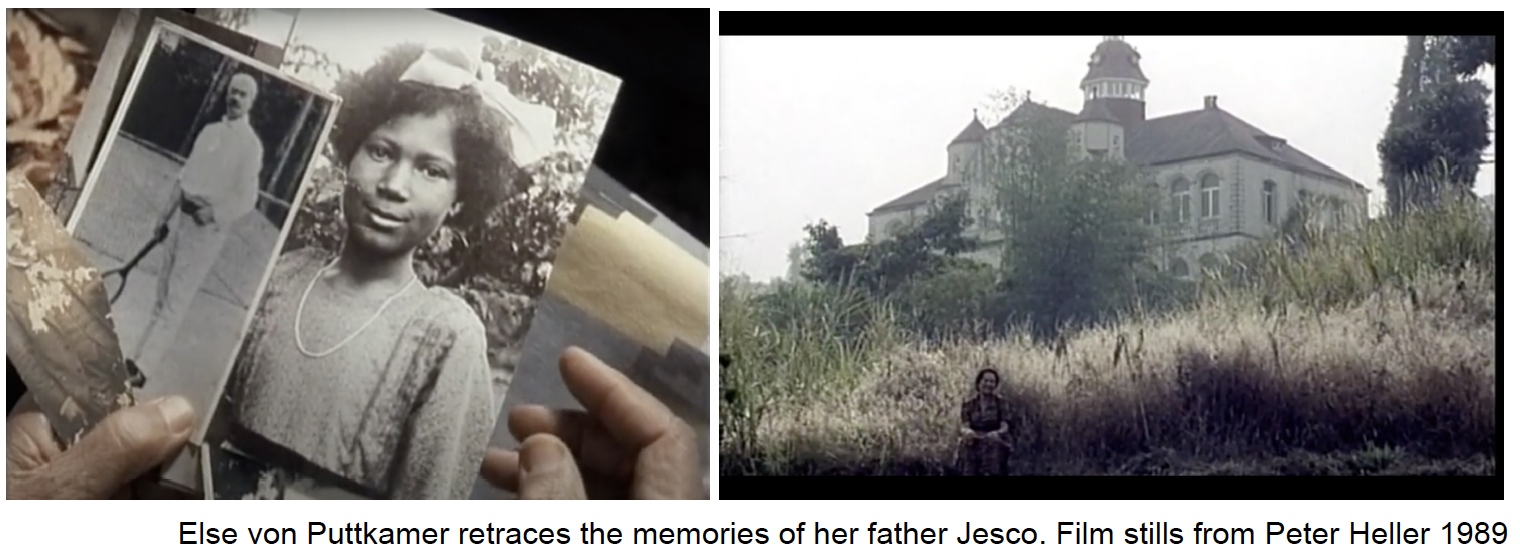photos: Thabo Thindi, Anguezomo Mba Bikoro, courtesy of Haus Der Kulturen Der Welt, 2022
TRIBUNALS - She*- Mangrove Archives Cases for Transformational Justice
Luke Collingwood / Rita Awuor Ojunge* / Burak Bektaş* / Nehande / Emine Zehra Zinser / Jesco von Puttkamer (Elsa) / Carl Peters / Ralph Zurn (+ Princess Nama) / Oury Jalloh* / Maria Mandessi Bell / Eugene Fischer / Verikitamma / Kinwo Venture (Okurin Prof.Hindu) / Nelly ‘Milli’ Guinn (Lüdwig Kirchner) / Solitude 1802 / Rasha / Benjamin Satiba Makgate / Jose Antonio Aponte / Kaera Kahitjene Ida Getzen Leinhos
Guest Artists: Savanna Morgan, International Women* Space, Wirya Budaghi, Pungwe, Donna Kukama with Nourbese Phillips, Ligia Lewis, Mathilda TheGreat, Wearebornfree! Empowerment radio
“The end refuses the imposition of silence; it is a bazaar, it is din and cacophony. It
demands a translation which is already...the place to come.
From the light-deprived mangrove where it roams, from
the ocean floor where it allies itself with other living creatures, the place sends out
cries and poisoned arrows. It rediscovers its cutting poetry that twists the neck of
administrative grammar.
It becomes unpronounceable.
Because it has learned to live in its death.”
Olivier Marboeuf
demands a translation which is already...the place to come.
From the light-deprived mangrove where it roams, from
the ocean floor where it allies itself with other living creatures, the place sends out
cries and poisoned arrows. It rediscovers its cutting poetry that twists the neck of
administrative grammar.
It becomes unpronounceable.
Because it has learned to live in its death.”
Olivier Marboeuf
TRIBUNALS - She*-Mangrove Archives is a series of fictional court case interventions based on conductive alliance practices with the living and the dead as transformational justice against the grain of institutional archival erasures. It selects the testimonies of
disregarded ecological debris, soils, plants and water algae as witnesses to crimes committed through emitted sonic vibrations. The title suggests that the term of investigations are positioned in a black feminist queer route of resilience invocation. It takes an observation on archival erasures & crime evidence files and how stories are re-written and conflicted with the personal experiences of victims (& of those accused) and those who design laws to legitimise superior judgement and crimes against humanity without holding accountability of violences committed. It presents lost, incomplete or closed cases of murders committed by the German Senate state against migrant, LGBTQ, Black communities, as well as internationaly known cases that have not been laid to rest accounting notably to the continuing colonial tradition of human trafficking in the tradition of resistituition and reparation. The tribunals imply a judicial body with a lesser degree of formality than a court. Normal rules and procedures for cases may not apply. Sometimes there are no judges, nor magistrates but private bodies, mangrove bodies. It appeals for the release of tormented ghosts and spirits, living and dead; building a performative zone of TRIBUNALS positioned within a black feminist experience in relation to jurisdictional power. The focus is mainly on, but not all, women* on trial and how the cases are ideologically constructed through patriarchal and plantocracy values. The sonic installation is a temporary situation taking an overview of original case files and disregarded archival material, personal experiences and fictional mytho-biographies, throughthe realms of juridical language. It renders modes of aesthetic counter-dominant narratives that make this discourse more porously visible, in which transgressions of human rights are transformed by invocations. The invocations & artistic mediations rom significant BiPOC artists and activists focus on aspects such as the violence of bureaucracy, various forms of stigma, and the topos of the courtroom, thus mapping a socio-political sphere of pain women* on trial, that is usually excluded from view by the hermetics of the juridical apparatus, and silenced in abundance of files. They provide access to black feminist queer knowledge in times of riot where protest propostions for routes to freedom come through ghost juridical unrest, becoming estranged healing archiving functions.
disregarded ecological debris, soils, plants and water algae as witnesses to crimes committed through emitted sonic vibrations. The title suggests that the term of investigations are positioned in a black feminist queer route of resilience invocation. It takes an observation on archival erasures & crime evidence files and how stories are re-written and conflicted with the personal experiences of victims (& of those accused) and those who design laws to legitimise superior judgement and crimes against humanity without holding accountability of violences committed. It presents lost, incomplete or closed cases of murders committed by the German Senate state against migrant, LGBTQ, Black communities, as well as internationaly known cases that have not been laid to rest accounting notably to the continuing colonial tradition of human trafficking in the tradition of resistituition and reparation. The tribunals imply a judicial body with a lesser degree of formality than a court. Normal rules and procedures for cases may not apply. Sometimes there are no judges, nor magistrates but private bodies, mangrove bodies. It appeals for the release of tormented ghosts and spirits, living and dead; building a performative zone of TRIBUNALS positioned within a black feminist experience in relation to jurisdictional power. The focus is mainly on, but not all, women* on trial and how the cases are ideologically constructed through patriarchal and plantocracy values. The sonic installation is a temporary situation taking an overview of original case files and disregarded archival material, personal experiences and fictional mytho-biographies, throughthe realms of juridical language. It renders modes of aesthetic counter-dominant narratives that make this discourse more porously visible, in which transgressions of human rights are transformed by invocations. The invocations & artistic mediations rom significant BiPOC artists and activists focus on aspects such as the violence of bureaucracy, various forms of stigma, and the topos of the courtroom, thus mapping a socio-political sphere of pain women* on trial, that is usually excluded from view by the hermetics of the juridical apparatus, and silenced in abundance of files. They provide access to black feminist queer knowledge in times of riot where protest propostions for routes to freedom come through ghost juridical unrest, becoming estranged healing archiving functions.
Black Guadalupan philosopher Gauthier Tancons, claimed that the state of exit-ing systems closer towards a decolonial moment would mean to sway your present by remaining invisible in a darkroom, for that which he calls the mangrove. The decolonial space is a constant
movement of a present-passing where the oppressed body constantly flees. Its meaning derives from fugitivity and displacement but in total astronomical accords historically recorded within the underground railway movement. Olivier Marboeuf explains that the moment of decolonisation is to flee within the space of an echo chamber of marronage calling for political re-sounding harmonised through the mangrove, an uncertain ecology and shifting soils as if fleeing from solid ground. A body unannounced working through its escape of its own imposed narratives of systems of oppressions to reconcile through its own imaginary and practice of finding their own archives for a safer space in which to learn to reveal ourselves in invisibility.
“This contradictory body ceaselessly flees and reappears, needs not burden with itself with the imaginary of another [ ] world.”
Pa pot kou en kaz ban mwen is an incantation of a means of revolt against and overcoming self-negation by unraveling all possibilities reflecting the truest forms of yourself effectively to bypass one’s postural ethics.
“We do not wish to be saved and refuse to save them in turn. Neither do we ask for them to share our privileges, but for those to be diluted in the movement towards a space that will suspend the order of things as we know it, towards a community in the making that fends off
becoming a commodity outside of its own experience, that never ceases to fleece to avoid becoming an object of the commerce of culture. The horizon of this community and the possibility of such alliances can not be formulated on toxic terrain, in a space that at once
turns them to capital. We want to be rid of privileges, invitations and horizons, we want to negotiate our way of being present, we want to flee.” O. Marboeuf
Cases
Cases re-opened comment on human trafficking against former General Jesco Von Puttkamer notably of Black women and children, trailing the legacy of one of many of his mixed race daughters, Else von Puttkamer whose mother was ‘gifted’ along with object relics and
that of the royal blue throne from Bamun by its Chief King Ndjoya. It was gifted to Kaiser Wilhelm in 1908 by the provenance and illegal acquisition of von Puttkamer. Hundreds of women from the area were formally gifted to the General as a way to insure peaceful and
secure fair land treaties and privileges concerned with German imperial law in the colonies. It introduces the anthropological discourse of restitution and reparation of objects as an opening to talk about reparation through the trafficking of human bodies which Nelly Guinn, Emine Zehra Zinser, Maria Mandessi Bell, Verikitamma and Rasha re-appear in court case of their own. Each of the women living archives and monuments to the time of the Weimar Republic working as underground spies nested within the cultural industry as a privilege towards better mobility & security. Ties and roots extend to the court case against Dr. Eugene Fischer.
movement of a present-passing where the oppressed body constantly flees. Its meaning derives from fugitivity and displacement but in total astronomical accords historically recorded within the underground railway movement. Olivier Marboeuf explains that the moment of decolonisation is to flee within the space of an echo chamber of marronage calling for political re-sounding harmonised through the mangrove, an uncertain ecology and shifting soils as if fleeing from solid ground. A body unannounced working through its escape of its own imposed narratives of systems of oppressions to reconcile through its own imaginary and practice of finding their own archives for a safer space in which to learn to reveal ourselves in invisibility.
“This contradictory body ceaselessly flees and reappears, needs not burden with itself with the imaginary of another [ ] world.”
Pa pot kou en kaz ban mwen is an incantation of a means of revolt against and overcoming self-negation by unraveling all possibilities reflecting the truest forms of yourself effectively to bypass one’s postural ethics.
“We do not wish to be saved and refuse to save them in turn. Neither do we ask for them to share our privileges, but for those to be diluted in the movement towards a space that will suspend the order of things as we know it, towards a community in the making that fends off
becoming a commodity outside of its own experience, that never ceases to fleece to avoid becoming an object of the commerce of culture. The horizon of this community and the possibility of such alliances can not be formulated on toxic terrain, in a space that at once
turns them to capital. We want to be rid of privileges, invitations and horizons, we want to negotiate our way of being present, we want to flee.” O. Marboeuf
Cases
Cases re-opened comment on human trafficking against former General Jesco Von Puttkamer notably of Black women and children, trailing the legacy of one of many of his mixed race daughters, Else von Puttkamer whose mother was ‘gifted’ along with object relics and
that of the royal blue throne from Bamun by its Chief King Ndjoya. It was gifted to Kaiser Wilhelm in 1908 by the provenance and illegal acquisition of von Puttkamer. Hundreds of women from the area were formally gifted to the General as a way to insure peaceful and
secure fair land treaties and privileges concerned with German imperial law in the colonies. It introduces the anthropological discourse of restitution and reparation of objects as an opening to talk about reparation through the trafficking of human bodies which Nelly Guinn, Emine Zehra Zinser, Maria Mandessi Bell, Verikitamma and Rasha re-appear in court case of their own. Each of the women living archives and monuments to the time of the Weimar Republic working as underground spies nested within the cultural industry as a privilege towards better mobility & security. Ties and roots extend to the court case against Dr. Eugene Fischer.
Written testimonies from the Blue Book by J. O’Reilly testify to the atrocities he committed in the experimentation on skulls of Black women. He used the skull of Namibian princess and medically experimented on Black women and during the uprisings and genocide of Herero & Namas peoples before his medical enterprise would be used and amplified as the machinery of torture during the Nazi regime on the extermination of Jews. *A princess’ skull was taken by grave-digger and colonialist German General of the Schutztruppe Ralph Zurn. He was responsible for the revolts, massacres and extermination orders against Nama and Herero peoples; digging the human remains and belongings of Namibian people to sale-export them to ethnographic museums in London, Dahlem Berlin and Dresden which are partly now part of the private ‘pharmaceutical’ (funded by Bayer) collections at the Humboldt Forum. We see maps and evidence of how the crimes were committed through psychological night visions by his daughter Unica Zurn following his ghost whilst on duty. Her torment in writing and in dadaist-termed drawings are given as evidence in the tribunal to hold accountability of the crimes committed by Germany linking to her father R. Zurn, E. Fischer and Carl Peters. Peters is put to humiliation by post-feminist Frieda von Bülow where her African science fiction novel Tropical Fever becomes the interlocuting evidence against her once beloved lover perpatrator and incites Chancellor Bismarck to remove him from his post in managing the German colonies. This comes with letters of his Black adopted children
kidnapped and hired by German aristocrats to serve the wealth of the German industry.
kidnapped and hired by German aristocrats to serve the wealth of the German industry.
Women* organising their own revolts and strategies of being present in invisibility, creating resistance through the practice of mangrove-darkroom. They testify together on the crimes of the cultural industry in music, circus and cinema; on the mass massacres of Black actors & Black colonial soldiers prisoners stationed in camps and the sexual human trafficking prominant in the experience of people identifying as women*. They all come into conflict with their own identities and political strategies and their voices collected from intergalactic space by satellite bouncing off its reflectors reveal a diary of black women* radio piracy with frequencies from Hamburg (1930) on the sexual
exploitation connected to the empiricism of the colonial project lead by lawyers and politicians. Former South-African soldier Benjamin Satiba Makgate and his grand-daughter Matilda TheGreat testify in personal diaries sent to open the court case against the Reishtag for the imprisonment & torture of African soldiers by ritual of a participatory walk of death as the sent verdict.
exploitation connected to the empiricism of the colonial project lead by lawyers and politicians. Former South-African soldier Benjamin Satiba Makgate and his grand-daughter Matilda TheGreat testify in personal diaries sent to open the court case against the Reishtag for the imprisonment & torture of African soldiers by ritual of a participatory walk of death as the sent verdict.
The case of Captain Luke Collingwood re-opens to reveal a prelude to this history of imperial design by slave-trade and the murders of all Africans from the Zong ship in 1781 and the testimonies of ghosts through breath, air and water frequencies. These testimonies are collected by ancestral healing re-enactments, exorcising of possessed spirits and re-imagining family roots. The voices are given to those which could not take a seat into the courtrooms and dismantles the arena of political empiricist design to flee towards a mangrove space taking account and holding your perpetrator, and reappearing in the different forms of the ghost through fictional release amidst historical tension and conflict. The origins of state and police brutality is exemplary in the cases of Oury Jalloh (marking 17 years of court without verdict), Rita Awuor Ojunge and Burak Bektaş murdered through racial violence in Germany. Their cases re-appear in the Tribunal series turning the space into burial grounds and dismantling the core of racist attacks with a fictional magistrate to assess the case for punishment against the perpetrators. Here comes a sequence of spells to haunt the spirit of the perpetrators at large where a built casket with velvet lining is left open.
The artist mediates on institutional archival violence and reflects on the often closed accessibility of information to descendants and BiPOC workers which transgresses human rights of accessibility of information in which additionally institutions claim to copyrights law over the authors of archival material. Some of these materials coming from diverse archive institutions state to be fully publicly accessible feminist enterprises under German law, yet notably perform sexual and racial discrimination, selecting candidates that appeal to continuing narratives of white saviouriousm. Sometimes they seemingly impose bans on Black researchers or claim that listed items are missing. According to the artist, monuments for justice cannot perform under the unaccounted modes of racial discrimination.






